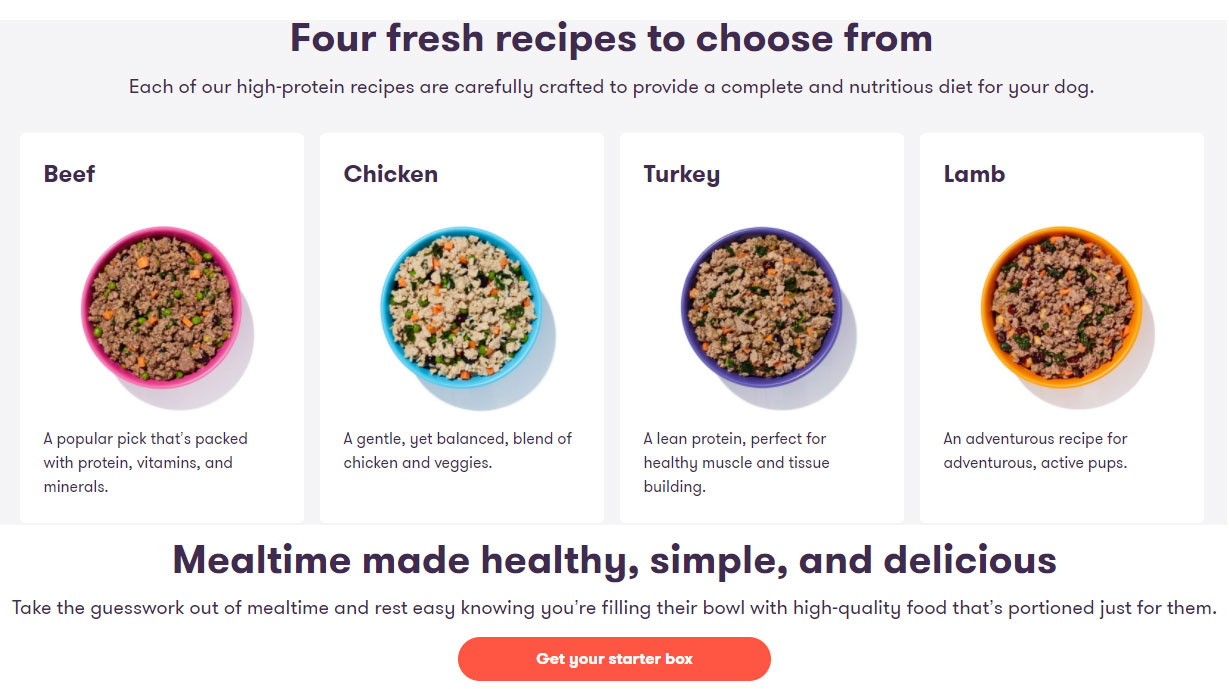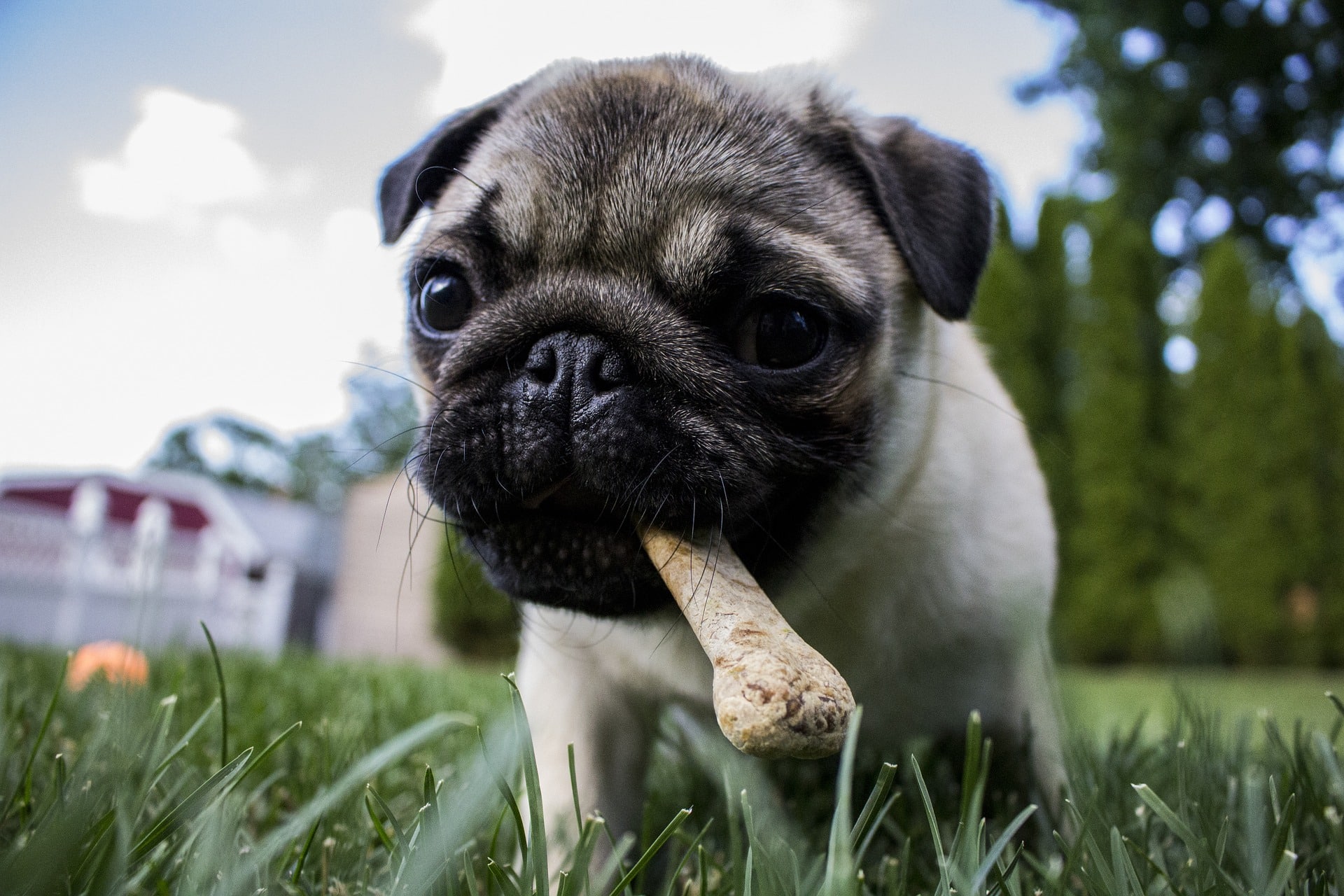Bones for dogs to chew
Giving your dog a nice bone often makes him very happy, but is it really recommended for his health?
Indeed, it is well known that our four-legged friends have a particular attraction for what is not good for them, and bones are no exception.
If they are sometimes used to maintain the jaw and the teeth of our animals, bones present many risks, sometimes lethal, which largely tip the balance against them. It is therefore sometimes appropriate to remove them from our pets' diet.
Bones for dogs, what are they for?
Giving your dog a bone seems to be a practice that goes back to the dawn of time. This strange food even seems quite natural in the mouth of our doggies, so much it resonates with his carnivorous nature.
Moreover, even today, many virtues are attributed to gnawing bones, which help maintain teeth and jaws, provide some nutrients and help fight boredom, loneliness and stress.
However, bones are no longer recommended, or even totally discouraged, by veterinarians, although there is still some debate on this subject among canine health specialists.
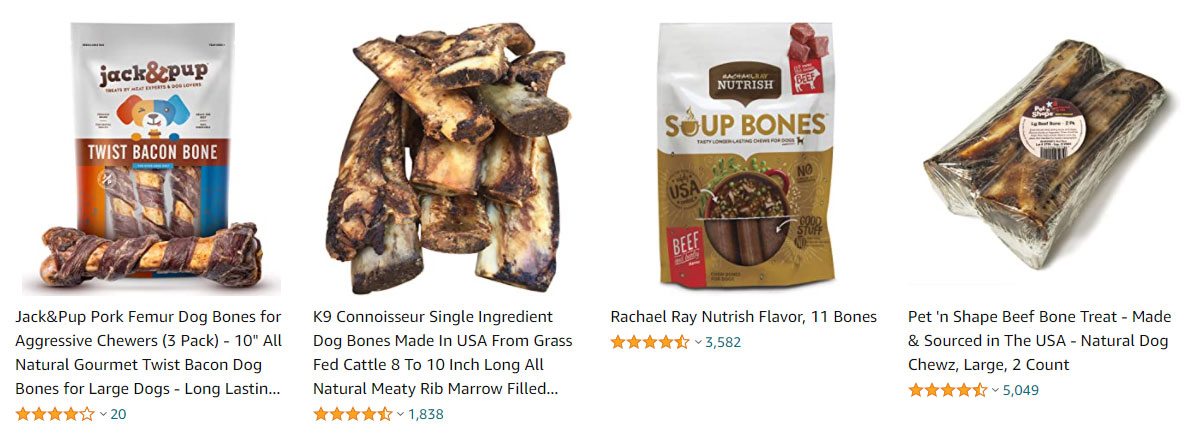
The benefits of dog bones
If bones are not yet entirely decried by dog health professionals, it is because of the benefits they can offer despite their dangers. The abrasive action of bones against a dog's teeth helps to remove tartar, preventing potentially serious periodontal disease.
Chewing and gnawing on a bone also allows the dog to exercise its jaw muscles. By keeping him busy for a long time, the bones also make valuable toys, which allow the animal to have a pleasant distraction. A real plus when you know that boredom is one of the first factors of stress and deviant behaviors in dogs.
Finally, bones contain calcium and phosphorus, and this is their only nutritional contribution. Cartilage is rich in collagen, but is not easily digested and therefore poorly absorbed by the dog. As you may have noticed, not all of these benefits are specific to bones, and it is easily possible to obtain similar benefits from other products without putting your dog at risk.
Finally, each of the above benefits also has its own disadvantages, which I will discuss in more detail in the next paragraph.
The dangers of dog bones
First, let's review the benefits of dog bones in terms of dental maintenance and oral health. These benefits are overshadowed by the number of dental fractures that occur as a result of chewing on bones.
Dental fractures can also become seriously complicated if not detected early. The calcium and phosphorus provided by the bones is not only already provided by a good diet, but is also associated with the ingestion of poorly digestible cartilage and ligaments, which can lead to gastrointestinal problems.
In addition to these relatively benign risks, bones can also cause more severe problems, especially when they are ingested in whole or in part. If swallowed whole, they can cause intestinal obstructions, which are true veterinary emergencies.
Bones can also break during intensive chewing, with the larger pieces causing lacerations of the esophagus and intestinal perforations, and the smaller pieces clumping together in the dog's intestine to form plugs that cause obstructions.
In addition to the risk of deep organ damage, bones can also cause a number of oral injuries by getting stuck in the animal's mouth or by breaking into small, sharp fragments. Marrow bones, on the other hand, are very high in calories and make extremely harmful treats over the long term when given too often.
All raw bones also present a health risk, as they are a breeding ground for bacteria and parasites that only cooking can eliminate. Among the most common bacteria found in raw bones are Salmonella, E. coli, Pseudomonas and Enterobacter, all of which can be transmitted to humans and cause severe illness.
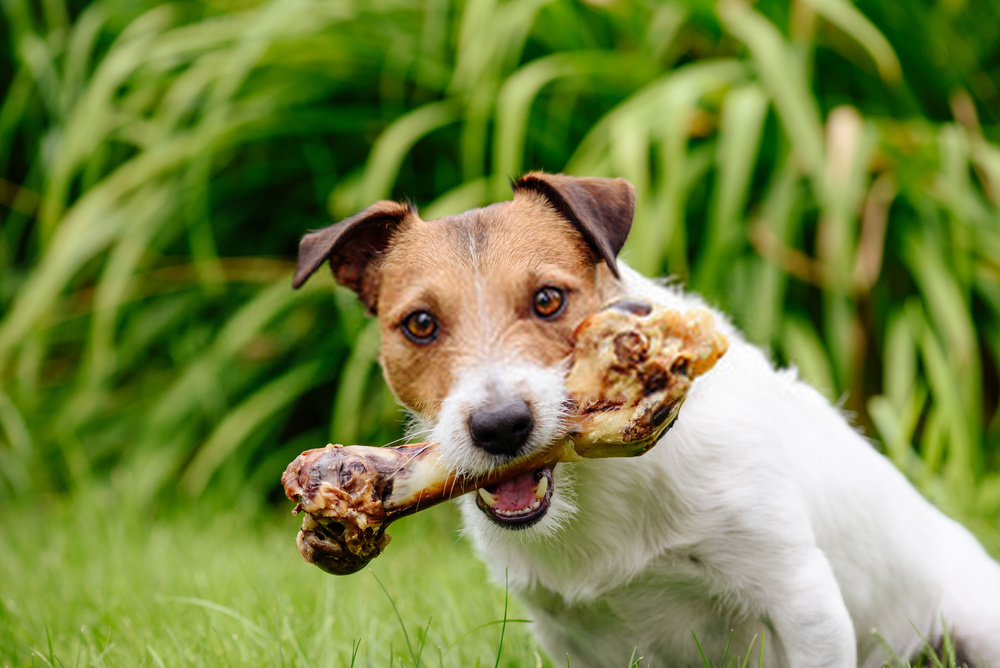
What bones to give my dog?
Although the majority of dog health specialists seem to be against bones, there are still a few more moderate veterinarians who continue to approve the consumption of bones, but under strict conditions. For all owners who insist on giving their dogs bones, it is important to remember that there is no such thing as zero risk, even if the good practices presented below are followed to the letter.
By following certain guidelines, the risk of intestinal obstruction and injuries caused by broken bones that have become sharp is minimal, but the danger of dental fractures and bacterial contamination remains.
First of all, never give cooked bones to a dog, although it may be tempting to heat them to eliminate bacteria. Cooking drastically weakens bones, and cooked bones are even more likely to break and cause severe, even fatal, oral or internal injuries. Therefore, only raw bones should be given.
Bones should be sized to fit the dog, i.e., at least as long as the dog's head (not just the length of the mouth). Bones that are too small can break or be swallowed. To be sure of your choice in terms of size, remember that there is no such thing as a bone too big for a dog, only too small.
It's better to choose a very large bone than to take the risk that it's a little too small and that your dog will swallow it or break it. Never give your dog poultry, rabbit or ovine (sheep, lamb, etc.) bones, as they are very crumbly and will quickly break into multiple sharp pieces.
The only exception to this rule is the distribution of fleshy bones - surrounded by flesh - intended to be swallowed by the dog as part of its diet, often BARF. Even if fleshy, these bones are still likely to injure your dog, so this is a practice I would not recommend, especially when you know that calcium - the only nutritional asset of bones - can be provided by other means in the context of BARF (bone meal, egg shells, etc.).
While large pig bones may be suitable (femur, tibia, etc.), large beef bones are ideal. Ribs and vertebrae should be avoided in all animals. A beef marrow bone should never be cut lengthwise (which makes it crumbly) and should be avoided in dogs that are overweight.
Also, a dog should never be left unattended while chewing on a bone, and the bone should be removed before it is buried or hidden. Indeed, as it decomposes, it becomes more fragile and, after 12 hours at room temperature, it becomes a real nest for bacteria.
Finally, bones are to be avoided without any exception in the case of dogs that are too vigorous and relentless chewers who will do everything to destroy it: there is no doubt that they will succeed, often leaving their teeth!
What to replace dog bones with?
To minimize all of the above risks, it is wisest to get rid of the old tradition of throwing your dog a bone. For heavy chewers, it's best to choose a good quality chew toy that won't crumble and get swallowed, or break the dog's teeth.
Kong toys, with their renowned strength, fit the bill perfectly, especially since they come in different degrees of hardness to suit both weak and strong jaws. To keep your dog's teeth healthy, you can opt for dental chews, which are specifically designed to fight tartar.
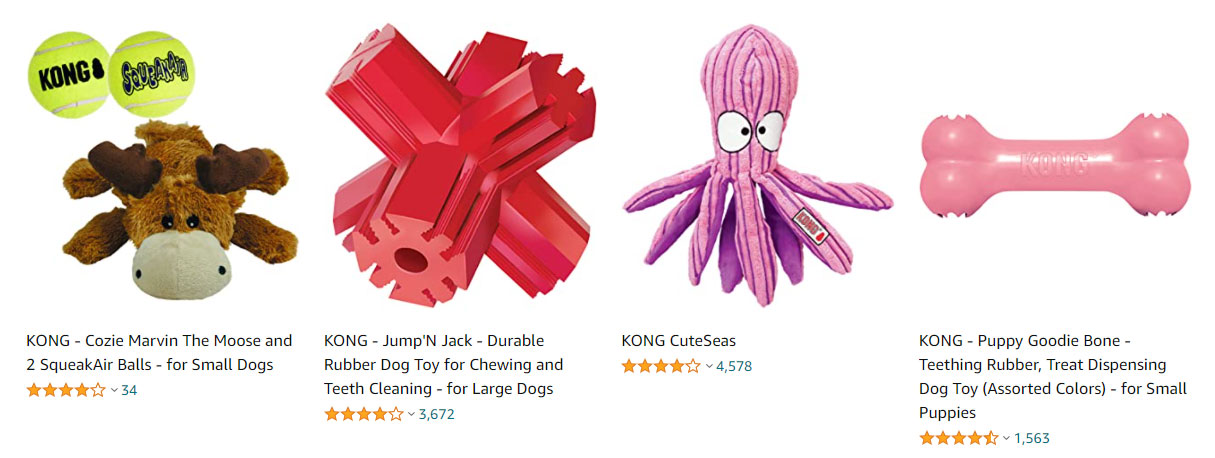
Both of these products are as beneficial to your pooch's oral health as they are to his morale, as they can keep him busy for a long time. The Kong toy, in particular, can be stuffed with dog food and bounces extraordinarily well on hard floors to keep your faithful companion entertained.
Artificial bones made of dried leather, on the other hand, are not recommended as a substitute for real bones. They all generate as many sharp splinters and may contain chemicals that are very harmful to our four-legged friends. They are also a source of bacterial infections and, as if that wasn't enough, give off a very unpleasant odor for the owner.
FAQ
Is it dangerous to give a bone to a dog?
Yes, giving a bone to your dog, even if it is carefully chosen, always involves some minor and severe risks.
Are bones good for dogs?
No, despite popular belief, bones are not good for dogs, except as a health hazard. They are not very nutritious, and their playful and beneficial role for oral health can be safely fulfilled by toys and chew sticks.
Can I give my dog cooked bones?
No, cooked bones are very fragile and could break and be ingested, causing intestinal obstructions, perforations, esophageal lacerations and mouth injuries. Although it may be tempting to cook a bone to eliminate bacteria before giving it to your dog, it is actually a very bad idea!
What bones should not be given to dogs?
To be safe, no bones should be given to a dog at all. Chicken, rabbit and sheep bones are especially to be avoided, as well as all cooked bones, regardless of the animal they come from.
Are bones good for dogs' teeth?
Yes and no. Gnawing on a bone allows dogs to remove tartar that forms on their teeth and reduces the risk of periodontal disease. On the other hand, dental fractures due to bones are very common. To remove tartar without running the risk, it is therefore advisable to give your dog chew sticks specifically designed for oral health.
Giving your dog a bone goes back to the dawn of time, and many owners find it difficult to see the dangers that this traditional practice poses to their dog. However, the risks caused by chewing on bones, whether it is a large beef femur or small rabbit bones, are very real and can have dramatic consequences, even lethal.
Today, the canine market offers owners many alternatives to bones, which allow us to entertain and treat our dogs without putting them at risk.
How do I choose the best diet for my dog?
For me, the easiest way is to trust the recognized professionals of the sector. This gives you the assurance to give your dog the right products while simplifying your life. For example, I recommend Ollie products.
It is a company with an excellent reputation that prepares customized recipes for your dog, 100% fresh and delivered directly to your home.
